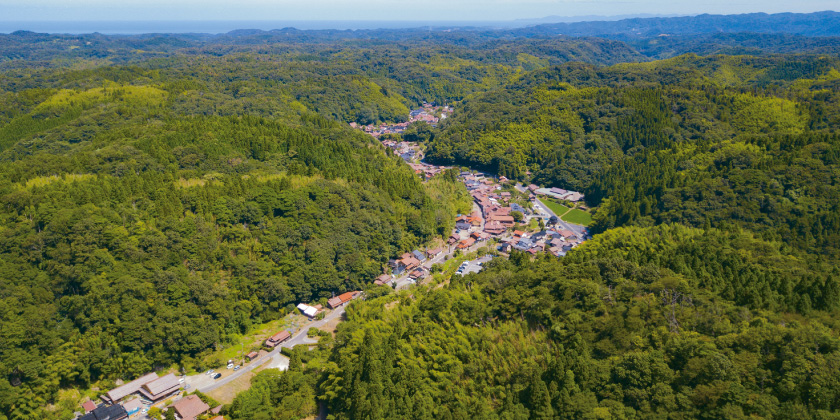
世界遗产,国立公园,世界第一的沙博物馆……历史遗迹与自然景观完美共存的岛根县大田市 位于岛根县中心位置的大田市是一个山清水秀的美丽城市,山毛榉郁郁葱葱覆盖的三瓶山中栖息着各种动物,紧邻市区的日本海深蓝色的海水悠然拍打着岸边的礁石,像游子眷恋着故乡。 2007年成功登录世界遗产的石见银山遗址是在世界产银历史中值得浓墨重彩的大型银矿山,昔日因银矿产业繁荣一时的大森地区静静地欢迎来自世界各地的游客,被指定为大山隐歧国立公园的三瓶山发现了远古时代的巨木林(被指定为国家级天然纪念物),10.2米的高度让人叹为观止。不仅如此,以优美如琴声的沙鸣而著称的日本海琴浜和拥有日本最大沙漏的「仁摩沙博物馆」都是大田市的标志。 此外,泉水涌出量丰富的「三瓶温泉」以及日本唯一处在世界遗产登录区域内的「温泉津温泉」也绝对不能错过。游客可以在品尝山珍海味的同时放松身心。陶瓷器爱好者也不虚此行,大田的「陶瓷之乡」拥有日本西部最大的攀登窑,传统手工技术烧制而成的陶瓷器深受好评。 拥有丰富自然与历史景观的大田一年四季都让人心驰神往,现在就出发去感受大田独特的魅力吧。
World Heritage Site Iwami Ginzan Silver Mine and its Cultural Landscape

Starting with its discovery in 1527, the Iwami Ginzan Silver Mine was one of the world’s most prominent silver mines for 400 years. During the Age of Exploration it was known only as “The Silver Mine” to Europeans and at its peak was responsible for one-third of the world’s silver production. It became a UNESCO World Heritage Site in 2007, the first such mine to be registered in Asia. The site also includes the surrounding transportation routes, ports, mining towns and hot springs. The great significance of the ancient remains of Iwami Ginzan Silver Mine lies in the fact that abundant traces of silver production from the mining sites to transportation routes have survived almost intact to this day.

Iwami Ginzan Walking MAP

Yunotsu Area

Located on an inlet on the coast of the Sea of Japan, Yunotsu is a port town adjacent to the Okidomari Port. The town became active in the later part of the 16th century as the administrative center of Iwami Ginzan and its surrounding areas. Yunotsu is also an old hot spring town that hosted local magistrates, prominent feudal lords, writers and artists. Houses line four alleyways and the main road along an 800m stretch eastbound from the port. The layout of the houses remains unchanged from the early Edo Period, with land allotted into narrow-fronted strips. Land use in this narrow valley area provides a vivid picture of how the town must have developed through dealings with Iwami Ginzan.

Nima Area

On the coast of the Sea of Japan 6km northwest of the Iwami Ginzan, Tomogaura in Nima area was the port from which silver and silver ore was shipped to Kyushu, during the years when Iwami Ginzan began to develop in the early 16th century. Early records show a flourishing port visited by many trading ships from Hakata to load silver ore. In the early Edo Period it became no more than a fishing village, and the consequent lack of major projects meant the original shape of the medieval port was preserved. Among the remains are the hanaguri-iwa moorings located on both banks of the port.
Besides the Tomogaura port, the beach Kotogahama in Nima is selected as Japan’s Top 100 beaches, and there is a sand museum which has the largest hourglass in the world.

Oda city and Coast

Oda city lies along the Sea of Japan, with 46km beautiful coast. The long coast is the best choice for fishing and sea bathing. Every summer, the display of fireworks on the Kute coast is also very impressive.

Mt.Sanbe – National Park Area

The highest peak in the Mt.Sanbe range rises 1126m above sea level. There are six peaks in this circular mountain range. The area is divided into four areas-NISHI NO HARA(west), HIGASHI NO HARA(east), KITA NO HARA(north)and Mt. Sanbe Hot Springs(south). Here you can enjoy activities all year around, from mountain climbing to hot springs, camping and so on.
Visit the nearby Mt. Sanbe Nature Museum and take a look at the trees buried by volcanic matter during the Jomon Period at the Sanbe-Azukihara Buried Forest Park.

Local Performing Art Iwami Kagura

Japan has a number of outstanding traditional arts and Iwami Kagura is one of them. Iwami Kagura can be traced back to a time when performances of dancing and music were dedicated to the deities of Japanese myth.

Local cuisine

Steamed fish paste (straw Kamaboko), flat seaweed (Ita Wakame), Sanbe Soba and other products made with ingredients from the sea and the mountain are available in Oda.

Iwami Ginzan Access Map

Iwami Ginzan silver mine Bus schedule













